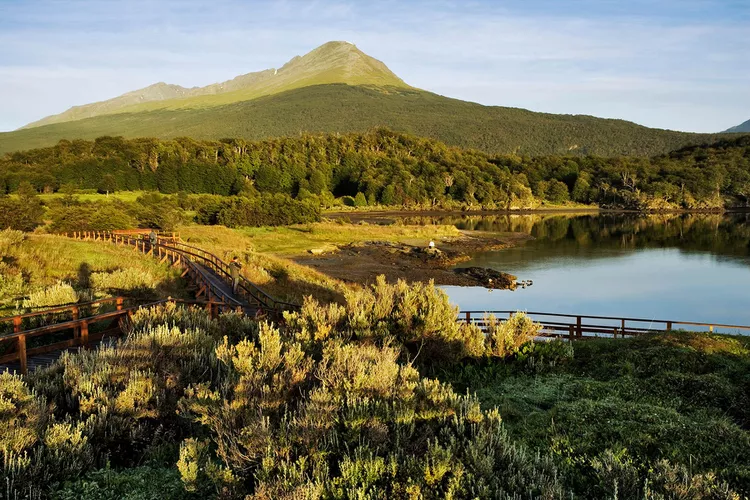Summary
Argentina’s Tierra del Fuego National Park
Tierra del Fuego National Park is closer to the Antarctic Peninsula than it is to Argentina’s capital city of Buenos Aires. This geographical distinction hints at what to expect from this extraordinary Argentine national park. However, rather than dismissing it as too cold or remote, consider its striking features: subantarctic forests, tundra, glaciers, and a vibrant coastline adorned with jagged peaks, thick beech forests, and diverse wildlife, including a relative of the camel.
Tierra del Fuego National Park may be small, but it plays a crucial role in conserving the Andean-Patagonian forests at the confluence of the Andes Mountains and the sea. Along with Ushuaia, it serves as the gateway to Antarctica, a continent known for its icy expanse and minimal human presence, coupled with abundant wildlife, including millions of penguins.
Tierra del Fuego feels like an alien landscape, and it certainly has a unique charm. Referred to as the “end of the world,” both Tierra del Fuego and Ushuaia mark the beginning of incredible adventures. Let’s review the essential details about visiting Tierra del Fuego, including when to visit, how to reach it, and the must-see attractions.
Things to Do in Tierra del Fuego National Park
Exploring the landscape of Tierra del Fuego is an unforgettable experience, as it is unlike anywhere else on Earth. The park offers over 20 miles of hiking trails, perfect for travelers looking to experience the wild beauty at their own pace. The Beacon Trail, which is open year-round, takes approximately 30 minutes to complete, guiding you from the Bahía Lapataia footbridges through a coastal forest, tranquil beaver farms, and eventually leading to the coast. Conversely, the Coastal Trail presents a more challenging four-hour trek through stunning coastal landscapes, available solely between November and April during the Southern Hemisphere summer.
For those who wish to immerse themselves in nature, kayaking or canoeing is an excellent way to explore Tierra del Fuego’s biodiversity and stunning scenery. Paddle around Lake Acigami or along the Lapataia River to take in breathtaking views of the mountains from the water. Ensure you choose a tour with an authorized park operator, such as Canal.
Additionally, you can visit the park’s beaches—Ensenada Zaratiegui, La Baliza, and Lago Acigami—which, while beautiful, are relatively chilly throughout the year. Sport fishing is permitted in the Lapataia and Ovando Rivers from November 1 to May 1, provided you obtain a permit.
Where to Stay Near Tierra del Fuego National Park
Camping is a viable option, allowing you to camp for free without a reservation. However, it is essential to be prepared for unpredictable weather and limited services. From November to April, campsites such as Pipo River, Cove, and Green Lagoon/Cauquenes provide toilets, although no other facilities. In contrast, the Walker Lagoon camp requires a strenuous eight-hour hike and offers no amenities.
For those seeking a bit more comfort than tents and restrooms, the urban center of Ushuaia features several options. The premier choice is the luxurious five-star Arakur Ushuaia Resort & Spa. Exceptional accommodations and exceptional cuisine are available, but it’s the spa that steals the spotlight, boasting expansive windows overlooking the water, outdoor hot tubs, and trails leading into the Cerro Alarkén Nature Reserve.
In addition, the three-star option, Hotel los Ñires is conveniently located along the coastline between Ushuaia and Tierra del Fuego National Park, providing easy access to both destinations.
When to Go to Tierra del Fuego National Park
The climate in Tierra del Fuego is characterized by cold and humidity, accompanied by considerable rainfall and potential snowfall. The ideal time to visit is during the Southern Hemisphere summer, from late October to April, when all trails are accessible and excursions are operational. Consequently, the longer days during this season allow travelers to make the most of their explorations.
Winter descends upon Tierra del Fuego between May and September, with heavy snowfall resulting in closed roads. During this time, cross-country skiing and snowshoeing become the preferred activities, replacing typical hiking and kayaking adventures.
How to Get to Tierra del Fuego National Park
Despite its remote location, reaching Tierra del Fuego is surprisingly convenient. The park entrance is a mere 15 minutes by car from Ushuaia Airport (USH), which is connected to numerous daily direct flights from Buenos Aires.
For an unforgettable arrival, consider taking the End of the World Train into the park. This ride offers a fascinating glimpse into the history of the prisoners who carved this path, all while surrounded by some of the most breathtaking scenery, including the Pipo River, La Macarena waterfall, and serene parts of the park.





